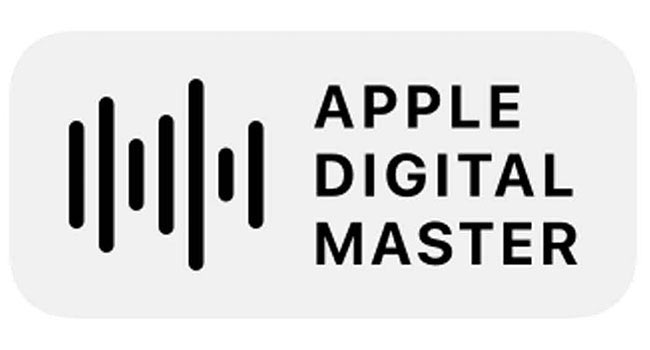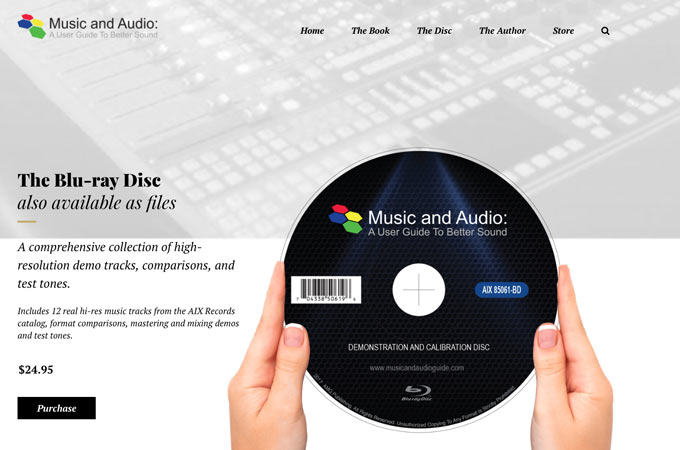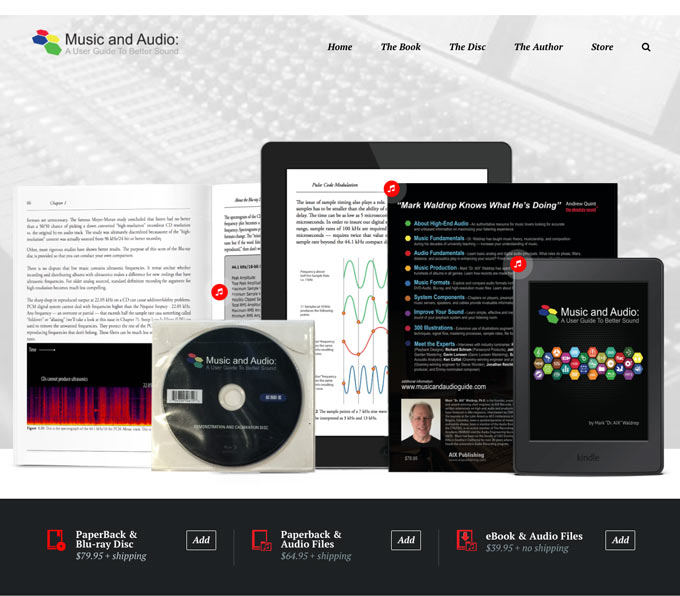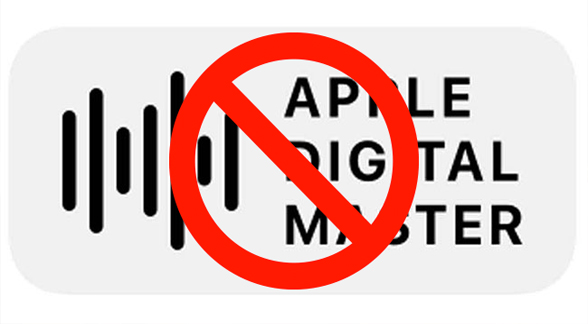Apple Digital Masters: More Hi-Res Nonsense
On August 7, 2019, Apple announced that iTunes was being replaced by Apple Music and that “Mastered for iTunes” — their high quality moniker for ultimate fidelity begun in 2012 — would be known as “Apple Digital Masters” going forward. Billboard magazine’s website was among the first sources to report this development and other organizations have chimed in with additional commentary. Now it’s my turn.

As a former mastering engineer and owner of a record label distributed directly through iTunes, I receive all of the communications from Apple and have all of the tools — hardware and software — required to meet their delivery standards. I remember being at a 2012 industry meeting when they asked that all future submissions to their platform be sourced as “high-resolution” — delivered as 96 kHz/24-bit PCM files. The news was accompanied by a couple of documents that define and discuss the new Apple Digital Masters. The first is titled Apple Digital Masters Source Profile, which includes a link to an “in depth description” called Apple Digital Masters: Studio-quality sound. For everyone. I’ve read each of these documents from top to bottom and can report that they continue to spew more of the same industry hype and misinformation about so-called “high-resolution audio” that the CTA, NARAS, and DEG have been shoveling for years. How unfortunate for the unsuspecting masses of music consumers that depend on Apple Music for their music listening.
All source audio submitted for branding as Apple Digital Masters has to meet the following requirements:
- Audio must be delivered at 24-bit resolution in an approved format.
- Acceptable sample rates are 44.1, 48, 88.2, and 96 kHz.
Unfortunately there is no mention of a recording’s provenance — the original format, native potential fidelity and associated limitations associated with the source format. For readers of this blog, this is old news and a recurring theme of my posts and the Music and Audio: A User Guide to Better Sound book. What good does requiring source files be delivered at 24-bits when the fidelity of the original master can be fully captured in many fewer bits? A typical album sourced from an analog master like the upcoming Abbey Road 50th anniversary rerelease has no more than 10-12 bits of dynamic range. Yet it will be called a “high-resolution” Apple Digital Master.

Remember that the number of bits in a PCM recording establishes the potential dynamic range of a digital recording. A 16-bit CD can deliver up to about 93 dB of dynamic range and 24-bits moves that number up past 140 dB. Never mind that there aren’t any commercially released recordings that even come close to the lower of those two numbers. My own AIX releases eclipse the limits of a CD but in reality no one can tell them apart from a 16-bit downconverted version. Compact discs have all of the dynamic range needed for virtually all released music. And what about the DSD format with its native 1-bit long words? Is Apple saying that all DSD recordings fail to meet their new standard because they use only 1-bit?
Using 24-bits during recording and post production is beneficial. The larger words provide audio engineers greater headroom, which means less clipping and intersample overs. But once you’ve mastered a recording for distribution there are no benefits to distributing 24-bits — except for marketing purposes. Apple certainly understands those benefits.
The technical brief — Apple Digital Masters: Studio-quality sound. For everyone — goes to great lengths and uses a lot of techno jargon to convince readers that “high-resolution digital recording” will bring new levels of fidelity to the Apple eco-system. They resort to using the same tired language that other organizations use such as “delivering music exactly as the artist intended.” But it’s all bunk — and Apple knows it.
The vast majority of albums in the archives of the major labels were recorded on analog equipment. The mastering houses at the labels are using substandard aging analog tape machines to do mediocre transfers through marginal quality ADCs to create the “96 kHz/24-bit PCM” masters that Apple requires. I’ve been in touch with one of the true analog tape gurus in the world and he laments that music enthusiasts have never heard the fidelity of those original master tapes in their digital form because of second rate transfers. The music industry is not interested in spending the money necessary to do first rate transfers so it really doesn’t matter what Apple calls them.
The music industry continues to promote “high-resolution”. They have agreed on specifications and definition, have developed logos and branding, but they have failed to address the question of provenance — the fidelity of the original recordings. Until they do, we’re never going to hear the music we love at the best possible fidelity. Apple Digital Masters isn’t studio quality sound for everyone. It’s a “feel good” sales slogan meant to enrich Apple and the music labels.
++++++++++++++++++++++++++++++++++++++++++++++++++++++++++++++
Music and Audio: A User Guide to Better Sound – A New Website
I’ve spent the last few weeks recasting the website for my book using a great WP theme called Booker. The new site includes a lot more information about the book, accompanying Blu-ray disc and the author. The new theme includes a “flipbook” that allows you to scan the entire Table of Contents. There just a lot more information about what has been called, “the Gold Standard” of books on high-end audio. And to thank all of my readers, I’m offering a special discount coupon for 50% off copies of the paperback version — with or without the accompanying disc. Use COUPON code MAAG190815 during checkout to get the discount.

Please visit the new website and let me know what you think. It’s still a work in progress. I’m adding and editing almost everyday. Click on the link Music and Audio Guide.
Thanks.


“True analog tape guru”? Sounds like Steve Albini.
Actually, it’s not. And I’m not sure he’d want me posting his name.
The issue of provenance could be easily solved in no time. In fact, it WAS solved in the earliest days of digital by something called the SPARS code. Mark, I know, remembers those along with the accompanying disclaimers about how the CD could reveal flaws in the original (analog) master tape. Both of these helpful pieces of information have long since disappeared from any delivery format. But an informed customer is the last thing the industry wants. They need a world of dumbbells in order to keep selling you the same content over and over.
The SPARS codes were a step in the right direction. The industry should come up with some new nomenclature but they won’t. I tried to get “hi-res transfers” accepted in the CEA Audio Board…I was eventually kicked out of the group.
I never got the whole “Mastered For iTunes” moniker. What’s the point of it if everything downloaded from iTunes is 196kps AAC files. I know many audiophiles had hoped lossless downloads from iTunes but it never came. So now the clock is ticking down to the end of downloads from iTunes(I predict it will happen next year) and arrival of CD-quality streaming on Apple Music(which I predict will never happen).
I believe iTunes AAC files are now all 256kps, and the are “indistinguishable from 320kps MP3 files.” (I can’t remember for the life of me where I read that initially, but I know I’ve come across this statement multiple times.) If that makes any difference…
Forward one year: virtually the entire Apple Music catalogue is streamed in lossless ALAC. (Sorry, couldn’t resist.) Apple may be as evil as they come but I don’t mind the audio quality.
Petar, I agree. They have stepped up and are delivering very good fidelity (with or without Dolby Atmos) for very little money. Now that lossless audio is the normal, smaller “so-called” HD streaming and download sites are going to have a hard time.
Wow, that commentary is long overdue. Maybe you’ll have more luck than I have with the topic. Most consumers appear to think the torrent of HD music comes from a Carrie Fisher style digging up of dead artists to fumble with Pro Tools or something (preferably in a bedroom with a thousand plug-ins). Anyway you only rent your music from Apple, so perhaps renewing the lease for another period with a “new” format is what they had in mind all along.